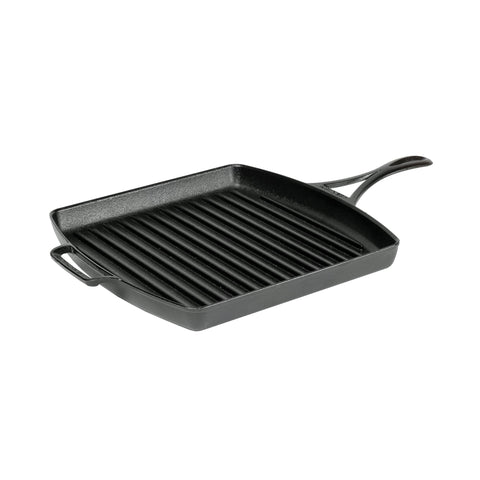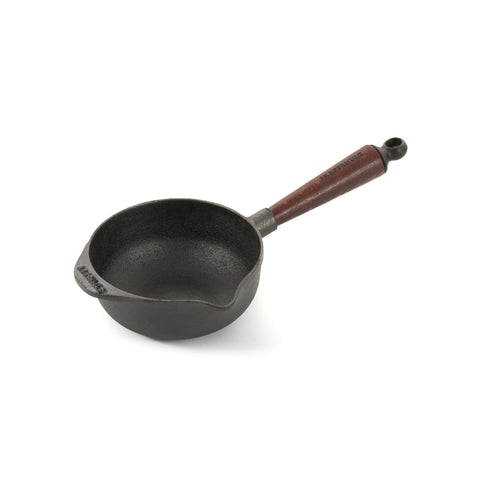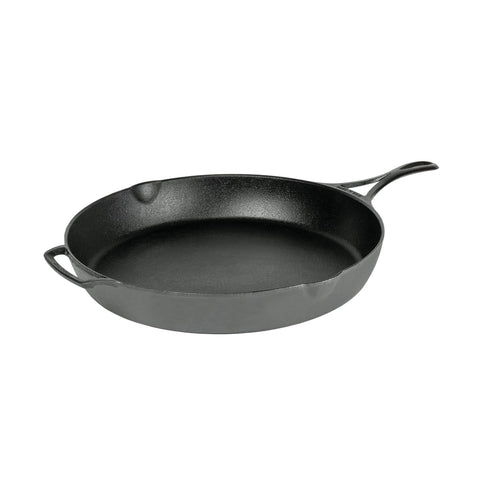Cooking With A Cast Iron Pan
by The Sous Chef Team

Cooking with a cast iron pan is something people have done for hundreds of years - bit its’s also one of the things we get asked about a lot at Sous Chef. Why is food sticking? How do you care for cast iron? What does seasoning cast iron mean?
In this guide, we will discuss how to use, maintain, and enjoy the unique qualities of cooking with your cast iron cookware. Whether you're a seasoned chef or a cooking enthusiast, maintaining your cast iron cookware will help you create delicious meals you can enjoy and share.
Sous Chef’s Cast Iron expert Kristin Lohse is our cookware buyer. She has many years of experience using, testing and cooking with a huge breadth of pots and pans. She shares her expertise from her career looking for the very best cast iron pans.
Become a cast iron expert, with our ultimate guide to cast iron pans. And browse all cast iron cookware at Sous Chef.
Or if you just want to know how to choose cast iron pans to cook with, below is a great video to watch about it!
What is cast iron used for?
Cast iron cookware is a staple for home chefs and cooks. It is hard-wearing, a great heat retainer, and lasts a very long time. Kristin adds: “Cast iron is not a very good conductor of heat. So to ensure even heat distribution, cast iron pans are.” made thicker to make up for the lack of conductivity
Here's a short list of ways to use cast iron in the kitchen:
- Searing: Cast iron skillets reach high temperatures, ideal for searing meats.
- Baking: From focaccia to fruit crumbles, cast iron provides even heat distribution for baking.
- Roasting: Achieve perfectly roasted vegetables with the skillet's consistent heat.
- Cooking on the grill: Cast iron withstands high grill temperatures, opening up more cooking possibilities.
- Frying and sautéing: Excellent for frying eggs or sautéing vegetables, ensuring nothing sticks.
- Oven-to-table: Not just for cooking, cast iron serves as an attractive serving dish, keeping food warm.
- Outdoor cooking: Its durability makes it suitable for camping and outdoor cooking adventures.
Remember, cast iron care is straightforward: clean, dry, and oil after each use to maintain its non-stick surface.
What is cast iron made of
A cast iron pan is crafted from a blend of iron, carbon, and silicone. This mix makes the pan durable and capable of withstanding very high temperatures. The carbon content is higher than in steel, lending the material its characteristic hardness and the ability to retain heat for long periods. Silicone in the alloy improves its resistance to wear and enhances its castability, making it easier to mould into pans.
This composition results in a cookware that excels in heat retention and distribution. It's why cast iron pans are ideal for cooking techniques that require consistent heat. They can go from stovetop to oven effortlessly, making them incredibly versatile. Plus, when seasoned properly, a cast iron pan develops a non-stick surface that improves with use. With adequate care, these pans can last for generations, becoming a kitchen staple that's as practical as it is heirloom-worthy.
How to use a cast iron pan
How do you use a cast iron pan for the first time? Starting right sets the foundation for decades of use. Here's a quick guide to the key steps when cooking with a cast iron pan for the first time:
- Season your pan: First off, wash your new pan with warm, soapy water. Dry it thoroughly. Coat the inside with a layer of vegetable oil, then bake it upside down in a preheated oven at 250°C for an hour. Let it cool in the oven. This process creates a natural, non-stick surface.
- Heat gradually: When you start cooking, remember, cast iron likes a gentle warm-up. Begin on a low setting, then gradually increase heat. This ensures even cooking and prevents food from sticking.
- Recipes to try: What to cook first? Foods that involve fat work well, like bacon or a grilled cheese sandwich. They contribute to the pan’s seasoning. Avoid acidic foods initially, as they can strip the seasoning you’ve just built up.
- Cleaning after cooking: While the pan is still warm, rinse it under hot water and scrub off any food bits with a non-metal brush or sponge. Dry it immediately and thoroughly. A light rub with oil before storing keeps it in perfect condition.
- Storing properly: Keep your pan in a dry place. If stacking with other cookware, a paper towel inside can prevent moisture buildup and protect the surface.
Do you put oil in cast iron before cooking?

Yes, adding oil to your cast iron pan before cooking is very important. It helps create a non-stick surface, preventing food from sticking and making cleaning easier. Here’s how to do it right:
- Light coating: Before heating the pan, apply a thin layer of oil. Use an oil with a high smoke point, like vegetable or rapeseed, to avoid smoking during cooking.
- Preheat the pan: After oiling, preheat the pan on a low to medium setting. This method ensures the pan heats evenly, enhancing its cooking performance.
- Cooking with oil: Whether sautéing vegetables or searing meat, the initial oil layer contributes to a richer flavour and a desirable texture. For instance, a steak gets a perfect sear, and pancakes flip flawlessly.
- After cooking: Post-use, clean the pan with hot water and a brush. Then, apply another light oil layer before storing. This routine maintains the pan’s seasoning for future use.
In summary, oil is essential for cooking with cast iron, benefiting both the food and the longevity of the pan.
How do you know when a cast iron pan is ready?

Knowing when your cast iron pan is ready for cooking is simple and crucial for achieving perfect results. Here's how to tell:
- The water test: Sprinkle a few water drops into the pan. If they evaporate, it's generally not hot enough as you want them to dance. The water should be so hot when it hits the pan, that a layer of steam forms under the water droplets, making them dance. You're aiming for the drops to dance or sizzle—that's when it's just right.
- ‘Shimmering’ oil: When preheating, watch for the oil to shimmer slightly. This indicates the pan is at a good cooking temperature, ideal for starting your recipe.
- Preheat time: Generally, heating over a medium setting for 5-10 minutes gets your pan to the correct temperature. This time frame ensures even heating, reducing the risk of hot spots.
These methods ensure you start cooking at the optimal moment, leading to delicious outcomes every time.
Is it ok to cook in cast iron every day?
Is it OK to cook in cast iron every day? Absolutely, using your cast iron pan daily can improve its seasoning, making it even better over time. Cast iron is ideal for a variety of dishes. Fry eggs, bake bread, or sear meat. Its ability to retain heat makes it perfect for both stovetop and oven use.
Benefits cooking in cast iron pan
Is it healthier to cook with cast iron? We’ve heard that cooking in cast iron can boost the iron levels in your food… It’s not a claim we’d like to stand by. But an interesting idea! At Sous Chef, we simply like to use cast iron for its culinary benefits. Here's why we think it's a smart choice:
- Natural non-stick surface: Seasoned cast iron provides a natural non-stick coating, reducing the need for large amounts of oil. This helps lower the fat content in your meals.
- Durability: Cast iron’s longevity means less waste from worn-out pans, making it an environmentally friendly option. It should last for generations.
- Versatility: Cast iron is suitable for various cooking methods. It transitions from stovetop to oven seamlessly, allowing you to sear, bake, broil, and more with just one pan.
What to cook with a cast iron pan
Cooking with a cast iron pan opens up a world of culinary possibilities. From sizzling steaks to golden cornbread, the options are vast. Here are some mouthwatering dishes to try:

- Steak: Achieve the perfect sear for a restaurant-quality steak.
- Cornbread: Enjoy a golden and crispy crust, a cast iron classic.
- Frittatas: Whip up a delicious and fluffy frittata with even cooking.
- Roast Chicken: Get a crispy skin and juicy interior when roasting a chicken.
- Pizza: Create a rustic and crispy crust by baking your pizza in a cast iron pan.
- Vegetable Stir-Fry: Achieve a quick and even stir-fry with high heat retention.
- Cobbler or Crisp: Bake a delightful fruit cobbler or crisp with a gooey center and crispy top.
- Baked Macaroni and Cheese: Get a golden and crunchy top layer for your mac 'n' cheese.
- Pan Pizza: Enjoy a deep-dish or pan-style pizza right from your cast iron pan.
- Grilled Cheese Sandwiches: Achieve a perfectly crispy exterior for your grilled cheese.
There are countless more options to explore, making a cast iron pan an essential tool for any home cook. There's a lot you can do, and these dishes are just the beginning of the delightful culinary journey with your cast iron pan. Gladly, we have an overall guide for you about cast iron pans!
What NOT to cook with a cast iron pan
While a cast iron pan is incredibly versatile, there are a few things you should avoid cooking in it to ensure its longevity and performance:
- Delicate Fish: Delicate fish varieties that may easily stick or fall apart are best cooked in a non-stick pan to prevent sticking or breaking.
- Tomato-Based Sauces: Prolonged exposure to acidic ingredients, like tomatoes, can compromise the seasoning of the cast iron, so it's advisable to use other cookware for these dishes.
- Eggs for Extended Periods: Cooking eggs for a prolonged period or using excessive heat might lead to sticking, making it challenging to clean.
- Citrusy Marinades for Too Long: Extended marinating in citrusy or acidic marinades can erode the pan's seasoning, affecting its non-stick properties.
- Dairy-Heavy Dishes: Cooking dishes with excessive dairy or cheese may result in a sticky residue that is harder to clean.
- Delicate Sauces Requiring Precise Temperature Control: Cast iron's excellent heat retention may not be suitable for delicate sauces that require precise temperature control.
While the list of what not to cook may seem specific, a cast iron pan remains a versatile and indispensable tool in the kitchen when used for suitable dishes.
What cast iron pan to buy?
Choosing the right cast iron pan can enhance your cooking versatility. Whether you are a starter in a kitchen or you’re an expert, here are some popular and versatile options for everyday usage:
Perfect for achieving grill marks indoors. This pan is excellent for cooking steaks, vegetables, or anything you want to give that distinct grilled flavor.
Versatile and convenient for making sauces, soups, or boiling small batches. The even heating ensures your sauces are well-cooked and full of flavour.
The all-purpose pan of the kitchen. Use it for frying, sautéing, baking, and more. Its versatility makes it a must-have for any home cook.
When selecting a cast iron pan, consider the type of cooking you most enjoy. Investing in a combination, such as a skillet and grill pan, can cover a wide range of culinary needs. Here at Sous Chef, we provide a collection of cast iron cookware.
Tips on cooking with a cast iron pan
Cooking with a cast iron pan opens up a world of possibilities. Here are some tips to make sure you cook well while taking care of your cast iron pan:
- Preheat Before Adding Ingredients: Ensure your pan is well-heated before adding food. This guarantees a perfect sear and prevents sticking.
- Explore Searing and Browning: Use the cast iron skillet for searing meats or browning vegetables. Its even heat distribution gives a delightful caramelization to your dishes.
- Utilise the Oven: Many cast iron pans are oven-safe. Transfer your pan from stovetop to oven for dishes that require both methods, like finishing a steak or baking a frittata.
- Experiment with One-Pan Meals: The skillet's size and versatility make it perfect for one-pan wonders. Try cooking entire meals in one go for easy cleanup.
- Harness the Retention of Heat: Cast iron retains heat exceptionally well. Let your pan heat up slowly for even cooking and keep your food warm for longer on the table.
- Maintain Your Seasoning: Regularly seasoning your cast iron pan builds a natural non-stick surface over time. This enhances its performance and durability.
- Avoid Drastic Temperature Changes: Cast iron doesn't respond well to sudden temperature changes. Gradually heat or cool your pan to prevent damage.
TRY: Read our buyer's guide on cast iron pans and check out our cast iron cookware collection!
Tips on properly cleaning and storing cast iron pan
Ensuring the longevity of your cast iron pan involves simple yet crucial steps:
- Cleaning and Seasoning Your Cast Iron Pan:
Proper cleaning is key to maintaining the integrity of your cast iron pan. After use, gently clean it with warm water and a soft brush or sponge. Avoid harsh scouring, as it can compromise the seasoning.
Once clean, ensure the pan is completely dry to prevent rust. Towel-dry or air-dry it thoroughly. Regular seasoning with a thin layer of oil builds up a protective coating and enhances its non-stick properties.
- Storing Your Cast Iron Cookware Properly:
Proper storage is equally important. Avoid storing your cast iron pan in damp or humid areas to prevent moisture, which can lead to rust.
Ensure there's proper ventilation in the storage area to avoid any lingering odours. Consider using a paper towel or a cloth between pans when stacking to protect the seasoning.
By adopting these practices, you'll not only maintain the performance of your cast iron cookware but also ensure its longevity for generations to come.

About the author
The Sous Chef team spends all day, every day hunting out the most exciting flavours, trends and recipes from across the world.
Every single team member tastes ingredients weekly, and cooks with the most up-to-date and classic cooking tools regularly. We're experts in ingredients and cookware from around the world.
We are constantly tasting new products, trying new recipes, and speaking to expert producers. For recipes and inspiration from the Sous Chef team, sign up for emails here.





